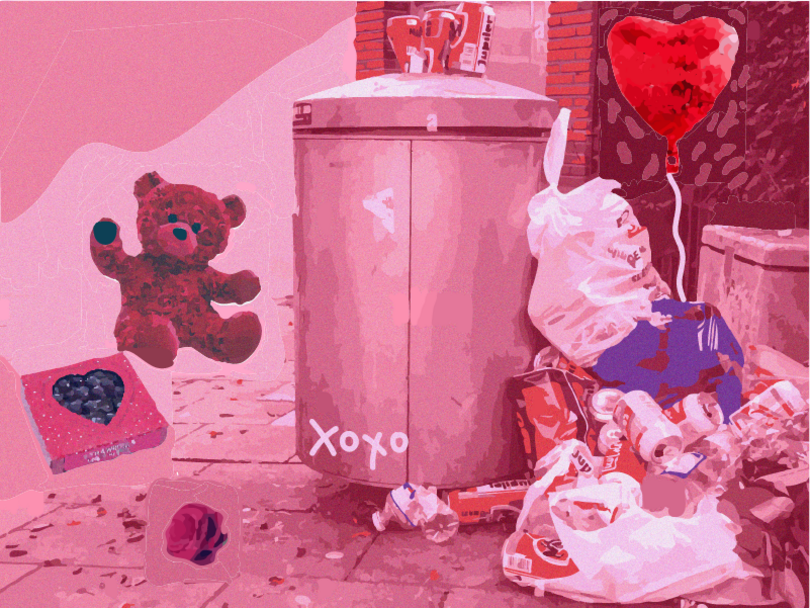Valentine’s Day is not so appreciative of the Earth it’s polluting

Valentine’s Day has a detrimental environmental impact each year due to the commercialization our society has turned the holiday into. Lindy Truitt | Assistant Illustration Editor
To support student journalism and the content you love, become a member of The Daily Orange today.
Love, sweetness, warmth… and waste? The idea of Valentine’s Day is beautiful, but the commercialization that society has turned it into is not. Each person has their own way of showing love, which should remain a priority. Unfortunately, regardless of one’s love language, corporate pressure around the holiday is unavoidable.
Love being a largely universal desire makes it easier for corporations to force capitalism through tangible gifts around Valentine’s Day. The one who suffers the most from a boom in production is the one we should love the most — Earth.
The immense waste that comes from Valentine’s Day sullies the sweetness of what the holiday is supposed to stand for. The International Council on Clean Transportation found 360,000 metric tons of carbon emissions could be attributed to the transportation of flowers in the three weeks leading up to Feb. 14. Because most flowers purchased on Valentine’s Day are out of season in the United States during the month, corporations must ship long distances. The rise in greenhouse gas emissions fails to account for the climate control-related energy used to keep flowers healthy, or packaging production to keep flowers intact. Both pile on more pollution.
Many decorations and gifts produced for Valentine’s Day are done so solely for the purpose of enticing people to spend money, to make consumers feel like they are truly honoring the tradition of the holiday. These items are cheaply made, composed of chemicals and often thrown out as soon as the holiday ends. Single-use products see a sharp increase around Valentine’s Day in various forms. According to the most recent municipal solid waste study in the U.S., 49.8% of garbage comes from plastics, metals, textiles and paper/paperboard — packaging for flowers is usually made up of plastic and cardboard.
Receiving flowers is sweet, but most people immediately throw out what they came in, put them in a vase and wait for them to die a couple weeks later.
Along with the amount of greenhouse gasses and waste entering the environment as a result of this holiday, human lives are being exploited.
Companies take advantage of the increasing demand for flowers by outsourcing their production to Columbia — where 80% of U.S. flowers are imported from — along with other Southern American nations. These countries have the ideal climates for flower growth during the Northern Hemisphere’s winter and workers who are easy targets to underpay. The harmful chemicals used to grow roses and other flowers have major health implications on the workers who are the backbone of the blooming industry, many of which are women.

Arlo Stone | Design Editor
U.S. presidents have used the ongoing War on Drugs to force an agricultural shift in Columbia from coca leaves to flowers. This has allowed the U.S. to further imperialize Latin America for profit, while presenting as saviors.
When you walk into any corporate store leading up to a holiday, you’re met with boisterous advertisements, usually in the form of available products related to the holiday. Corporations know they can target people when they’re shopping for essential items. These ads are an immediate reminder of what corporations want the holiday itself to resemble. During Valentine’s Day, this pressures us to buy monetary items in order to show love. As a consumer, the decision gets placed on you to avoid the obnoxious products. If you fail to participate, you may feel like you are not showing proper love to your partner. If you buy in, the corporations profit and you get a small dopamine rush from giving a gift you’ll see die in a couple days.
However, it’s not the consumers’ fault. We should be able to buy these cute gifts, flowers and jewelry without it harming the environment. But under the circumstances of our current society, we need to be more cognizant of what we purchase for loved ones to ensure people and the planet are protected in the process.
In the current state of our planet, we need everyone working together to fight the major systemic issues harming our planet and so many people on it. Our Earth provides unconditional love and life to all, and respect for its grace shows strength in love. To better our relationship with our planet, means bettering our relationships with the beautiful people on it.
As consumers, we can push back with our dollars. It is widely understood that the only thing corporations care about is money. Try sharing experiences instead of gifts. And when choosing to give tangible items as a show of love to a valentine, think about regifting instead. Purchase plants that are region-appropriate and in season. Consider making your own present, and buy biodegradable and locally sourced products.
Conor Sarasin is a Junior Environmental Studies Major. His Column appears bi-weekly. He can be reached at cjsarasi@syr.edu.





